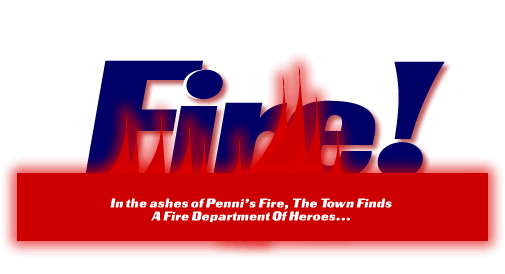"The fire quickly went through the roof, threatening buildings on both sides and beyond."
 It was a quiet night, that night Penni's burned to the ground, almost taking the entire downtown historic district with it. It was a quiet night, that night Penni's burned to the ground, almost taking the entire downtown historic district with it.
The Town was asleep. Police were quietly patrolling. The Fire Department headquarters was dark except for the lights on in dispatch.
It was just a yellow haze of intent when it started. It became a raging inferno that engulfed a landmark and brought fire apparatus and firefighters from sixteen communities thundering into Marblehead in the wee, small hours of September 5, 1994. Like retina burn from the fire, the after images and frightening potentials of that conflagration remain in the eyes and hearts of downtown residents and leaders of the Town long after the fire was out.
"It was the worst fire I have seen in 29 years on the Marblehead Fire Department. Potentially, it could have been the disaster we all fear in the historic district." Chief Charles Maurais did not mince his words.
"Just before the wall collapsed, fire curtain is laid down."
Police Officer Keith McClellan was on duty the night of Penni's fire. Patrolling the Neck, he was cruising back across the Veterans' Memorial Causeway at about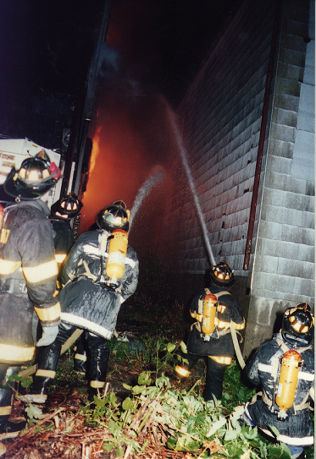 2:30 A.M. Alertly, he noticed an orange glow in the downtown area where there should have been no glow at all. He radioed it to police headquarters. The Fire Department had already received a citizen call and firefighters were manning Engine #2 as the police call came in. Lieutenant Terry Powers, Dan Rice, and Rick Bartlett jumped into the fire truck and roared out of the station in response to what they thought would be a "dumpster fire." As they came around the corner on Washington Street, they could see the glow of flames and they called for a dispatch of all apparatus. And, at that time, Lieutenant Powers struck a second alarm. Chief Maurais arrived quickly on the scene, and after a quick survey, struck a third alarm. Before the night was over, it went to seven alarms involving at least sixteen communities and over twenty-four hours of firefighting. 2:30 A.M. Alertly, he noticed an orange glow in the downtown area where there should have been no glow at all. He radioed it to police headquarters. The Fire Department had already received a citizen call and firefighters were manning Engine #2 as the police call came in. Lieutenant Terry Powers, Dan Rice, and Rick Bartlett jumped into the fire truck and roared out of the station in response to what they thought would be a "dumpster fire." As they came around the corner on Washington Street, they could see the glow of flames and they called for a dispatch of all apparatus. And, at that time, Lieutenant Powers struck a second alarm. Chief Maurais arrived quickly on the scene, and after a quick survey, struck a third alarm. Before the night was over, it went to seven alarms involving at least sixteen communities and over twenty-four hours of firefighting.
The quiet night had suddenly translated itself into a night to remember.
"Cleaning up after 24 hours of firefighting, Penni's ends with the push and pull of a backhoe."
For many, Penni's Supermarket was a daily reminder of times gone by when the downtown (or "Old Town" as some now refer to the historic district) had two supermarkets: Louis' and Penni's, which competed against each other for the active and upscale trade of the neighborhoods surrounding Pleasant and Washington Streets. It was a time when stores like Chadwick Hardware, Sheppard's Drugstore and McLain's Fish Market prospered.
 Many former Marblehead boys who now drive to Boston wearing Hickey Freeman suits can remember wearing the lowly apron of a shelf-stacker or carrying bags to cars in the parking lot for elderly patrons. Many former Marblehead boys who now drive to Boston wearing Hickey Freeman suits can remember wearing the lowly apron of a shelf-stacker or carrying bags to cars in the parking lot for elderly patrons.
Jim Crosby, who bought the supermarket in 1989 from Sam and Frances Penni, was confident that the store could be rebuilt and eventually reopened. No one could imagine the area without a full-service grocery store. But, walking by the after-fire site, when one saw a dark, smoldering crater rather than a well-stocked aisles and active cash registers, it was a daunting prospect.
Even the movements of the backhoes were a big improvement since the night of the fire.
Marybeth Reynolds was sound asleep when her lungs filled with smoke. Coughing, gagging and very confused, she assumed her apartment home was on fire. In the hallways, her neighbors were screaming and knocking on doors. Staggering out into the night, reality became clear. "It was the scariest thing I've ever been part of," she said. But frightened, confused and cold, she grabbed her cameras and took the only known pictures of the raging fire. The album she later compiled for the Chief tells quite a story. The streets that night were like a war zone, with fire apparatus everywhere, hundreds of emergency lights strobing, and fire hoses, like veins and arteries bulging and pulsing with the supermarket's lifeblood: water to stop its destruction.
In the end, Penni's 60-year history and the sense of well-being of the neighbors, businesses and owners of property throughout the Town all passed through a sea change that night. The loss was material only at first, then it grew as the scope of the destruction became fully known. The students and faculty of the Coffin School, sensing the vacuum, rushed in to fill some of the emptiness with a heartfelt mural depicting the downtown area as it was then and they hoped it would be again. People walked past the mural and looked beyond it to see the masts of the sailboats in the harbor for the first time from that location. Without the peaked roof of Penni's, the harbor's tallest spars were visible from Washington street.
What caused all of this? Perhaps, beyond anyone's control, an arsonist, distraught and depressed, was just beginning a month-and-a-half wave of pyromania that resulted in over ten fires and an estimated $1.25 million worth of damage around the Town. In its final stages, the serial fires threatened the lives of a sleeping family on the conservation-edged Fox Run Lane weeks after Penni's.
The men and women of Marblehead's Police and Fire Departments worked around the clock to stop the fires and bring the arsonist to justice, and in their experiences lie the true heroism and history of Marblehead's fiery Fall of 1994
Charles F. Maurais, Chief, Marblehead Fire Department
Q: Where were you when the call came in?
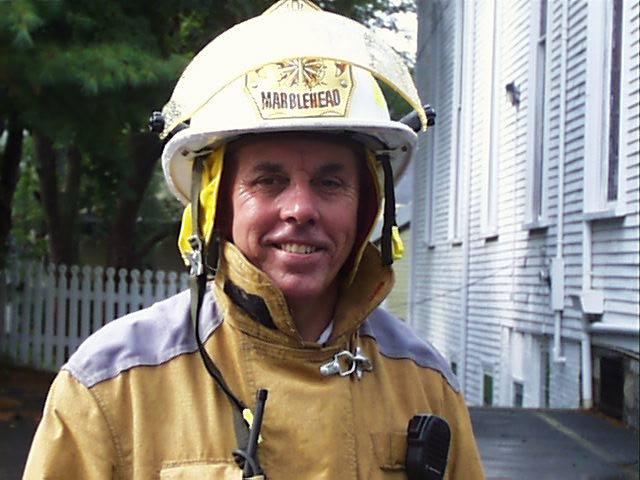
A: When I received the call while I was home asleep. I was on the scene five minutes later. By the time I got there, a second alarm had been called in, and I called in a third alarm immediately.
Next, we set up a command post in front of the building and began procedures to prevent the fire from spreading to the apartment building to the right of Penni's. Aerial ladders were set up to spray down on the fire. It quickly became obvious that there was going to be a need for a lot more equipment and firefighters than Marblehead alone had, if the fire was to be contained.
Water pressure became an issue as more and more equipment was hooked up. We then called the Water & Sewer Department and Dana Snow pushed it up to 100 PSI to 105 PSI from the normal 80.
The back of the building was fully involved. There were firefighters on the roof of the building. I ordered them off the roof and within half an hour, it collapsed. The men were fighting the fire very courageously in the close space between the buildings. It was especially dangerous for them when the walk-in freezer collapsed. Several firefighters were in the alleyway, protecting the Mugford Building and just made it out in time. It would have been a death trap in there if they hadn't gotten out.
We worked through the night and into the next morning. There were hundreds of bystanders watching and the crowds had to be controlled with fire lines. Over 100 firefighters, 12 pumpers and five ladder trucks, all working together under my command for over twenty-four hours... it was very demanding and exciting. The men performed outstandingly. When the "All-out" was sounded at 10:37 A.M. on Tuesday, September 6th, we all gave a huge sigh of relief.
Hooper Cutler, Captain, Marblehead Fire Department
Q: When did it become obvious that this was no "dumpster" fire?
A: When the call came in (I found out later), it was a kid on Darling Street. I picked up the phone and he said, "The dumpster down by Penni's is on fire." We thought it was just the dumpster down behind the building in the parking lot. So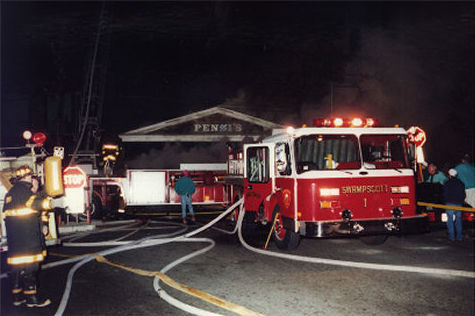 I called for Engine 2. The rest of us, without discussing it, were already thinking it might more but we hoped not because of the cardboard compactor/container attached to the building. We all knew that could be a real problem. We jumped up and got suited up and edged our way in the direction of the engines, waiting for the on-site report. When we heard from the men on the scene, we dispatched everything immediately. Terry Powers called for a second alarm from the fire. When we got there, it was obvious that we wouldn't be able to handle it without help, so I struck another alarm. Then we got busy hooking up to large diameter mains. This was really going to be something. I called for Engine 2. The rest of us, without discussing it, were already thinking it might more but we hoped not because of the cardboard compactor/container attached to the building. We all knew that could be a real problem. We jumped up and got suited up and edged our way in the direction of the engines, waiting for the on-site report. When we heard from the men on the scene, we dispatched everything immediately. Terry Powers called for a second alarm from the fire. When we got there, it was obvious that we wouldn't be able to handle it without help, so I struck another alarm. Then we got busy hooking up to large diameter mains. This was really going to be something.
And it was a real muster before it was over. The streets looked like a bowl of spaghetti with all the hoses and equipment. The Marbleheaders worked like hell and stayed at it right to the end. The other towns' men and equipment were fabulous. When the building to the right "lit up" in the second and third floors, we knew it was close to getting out of hand. Just then the ladder from Beverly showed up, followed right away by the engines from Peabody and Lynnfield and together we saved the adjoining building. Everyone did one hell of a job.
Terry Powers, Lieutenant, Marblehead Fire Department
Q: You were first on the scene. What were your thoughts and what did you do?
A: The fire was already into the building and our first concern was to keep the fire from spreading into the Mugford  Building or onto the white building on the right. We got some of the hoses off the trucks and I went around to the front to see how far the fire was into the building and a second alarm was struck, bringing Swampscott into play. If that Mugford Building had got going it could have gone all the way to State Street. Once the heat builds, radiant heat is so intense the fire doesn't even need to touch the buildings around it to ignite them. That thought crossed my mind. Building or onto the white building on the right. We got some of the hoses off the trucks and I went around to the front to see how far the fire was into the building and a second alarm was struck, bringing Swampscott into play. If that Mugford Building had got going it could have gone all the way to State Street. Once the heat builds, radiant heat is so intense the fire doesn't even need to touch the buildings around it to ignite them. That thought crossed my mind.
There were two firefighters from Marblehead working with three from Swampscott. They had a stream of water between Mugford and Penni's (a water curtain to keep the fire from spreading) and, suddenly, the back of Penni's collapsed. It sent these guys flying ass over teakettle. They dove down to the embankment and they were really lucky they weren't trapped as the building collapsed. I ran towards them hoping, but not knowing, they were safe. It happened so quickly. It scared the hell out of everybody.
Dan Rice, Firefighter, Marblehead Fire Department
Q: You were driving the first engine to arrive. You didn't really know what you were getting into at that moment. How did the system perform?
A: The system worked very routinely. It started as a dumpster fire at Penni's. Everybody was ready to go, even though only one engine was going, everyone was ready. When the second alarm went, everything was on road or at the fire. We started to hook up the first attack line and as we emptied the truck, we were hooking up supply lines right then.
I was very comfortable with the situation. Everyone was calm and very professional. You always wonder what it will be like and this happened and I was there. Everybody was doing their job, our guys were really good at this fire. Lieutenants, captains and the chief were all great.
Rick Bartlett, Firefighter, Marblehead Fire Department
Q. You were on the back of Engine #2 in the jump seat, the first engine to arrive. What were you thinking about?
A: On the way, we thought it was just a dumpster fire, so I was preparing for that. But when we got to the top of the hill by the Baptist Church, I could see the fire was already jumping over the roof of the building. I knew then that we were in for the long haul. When we got there, the first thing I saw was the two windows above the trash shoot, it was all fire in there,  and I knew we would really need help. and I knew we would really need help.
I had the hoseline (the attack line) from the truck and knocked down the dumpster. The windows at the street level were broken, out back that was the second level, we tried to knock the fire down there as well. In nothing flat we ran out of water. That's 500 gallons' in from the pumper. The adrenaline was pumping as well as the water. I could tell that without a lot of help it was a losing battle. I could hear the other trucks coming with their sirens, and those few minutes seemed like hours.
At one point, we were out in back between the buildings and the part of the building we were standing on collapsed. It was bowed out in the middle and you could tell it was going to collapse. We were pouring water on the Mugford Building. I could see the steam rising and there was a loud bang and cracking. The next thing I knew, I was on my back with a lot of people on top of me and people coming from all around checking on us and helping us get out of there. It was a weird feeling to be all twisted around suddenly, beyond your control. One second everything's OK and the next it's totally not. We got up, checked each other out, and went back to fighting the fire, glad to be alive.
It was after daybreak that we really started to feel like the fire was under control.
Dana Snow, Superintendent, Marblehead Water Department
Q: A lot of people probably don't know the role you and your department played in this fire. Where were you when you heard about it?
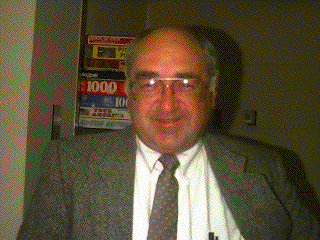
A: I was home asleep. I came to Tower to check on the pressures, because of so many trucks in town. The downtown area is the hardest to facilitate with high pressures. I put the second stage pump on and went to the fire to read the inlet pressures from the trucks. Pressures were beginning to drop. I went to the new Loring Avenue pumping station and we juggled the pumps to get the maximum pressure on line for the fire. We stayed with it all night. We've been planning for a fire like this for at least ten years. Because of that long-range planning we were ready and the Fire Department did a wonderful job.
* * * * *
It doesn't take the eye of a career firefighter to see the scope of this fire, or to sense the near-to-disaster precipice on which Marblehead tettered the night of Penni's fire. It was the swift response and the determined professionalism of Chief Maurais and his men and women that brought us back from that seminal moment to these pages of reflection and historic record. One never hears the legends of fires that were never fought, but that is the strength of our department: fires prevented and fires stopped before they fulfilled their wanton destiny. And then there are are fire that burned.
This was the fire that could have been our worst nightmare. It came upon us in the middle of the night and it was arson not accident. The firefighters of the Marblehead Fire Department and the men and women of sixteen other communities rushed to the rescue and saved the downtown. Those communities deserve our thanks as well, because they, too, struggle with municipal funding and priorities and they, too, held the line and had the manpower and equipment needed to protect our historic district.
The fire seared its way through a landmark, and scorched the hearts of Marbleheaders. The scars and the glory remain as reminders to future generations to always be prepared.
|

|
|
|

